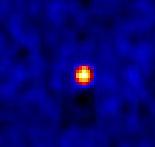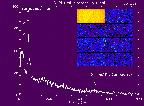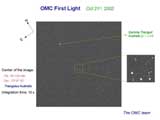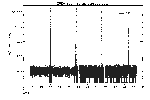 INTEGRAL pictures and videos
INTEGRAL pictures and videos
 INTEGRAL pictures and videos
INTEGRAL pictures and videos
(click on thumbnail image to view it in original size)
|
|
First astronomical image (17 November 2002) from Cygnus X-1 
|
IBIS/Veto system, module VDM-09, spectrum
with 511 keV line  |
IBIS first full activation: PICSIT
detection plane image with all
the modules vetoed: energy range ~180 keV- 5 MeV (collected November the
7th)  |
First light data from the low energy detector array ISGRI of the
IBIS imager. For thermal uniformity reasons, all 8 modules were
powered but only one module (shown in yellow) was biased to -120 V for
about one hour. The module temperature was around -10°C. On the picture
one notes the good uniformity of the active module and in the spectrum
the W and CsI (probably) fluorescence lines as well as a weak 511 keV line
due to the calibration source. The threshold was very low (close to 10
keV), it results in part from the exceptionally low temperature. This tests
demonstates the excellent performance of ISGRI. |
The
first
light image is showing the first
shadowgram of the detector module 1 of IBIS/PICsIT and the spectrum
of single events of the same module.  |
|
|
First astronomical image (17 November) from Cygnus X-1 
|
| The SPI telescope aboard INTEGRAL has detected during the period from
9-Nov-2002 (12:00) and 11-Nov-2002 (12:00) a considerable increase of gamma-ray
line emission in the energy range 2-8 MeV. In particular,
broadened and shifted gamma-ray lines have been observed around 2216 keV,
3009 MeV, and 4452 keV. Increased but narrow gamma-ray line emission has
also been seen at 6129 keV.
The increase of gamma-ray line flux is correlated with an increase of the SPI anticoincidence (ACS) overall counting rate, and an increase of the 1-100 MeV proton flux as seen by GOES8 (see http://www.lmsal.com/solarsoft/last_events). The origin of the gamma-ray lines is not fully understood so far, yet the measurements impressively demonstrate the capacity of SPI to perform detailed studies of gamma-ray line profiles. For example, the spectrum at 2.2 MeV is composed of a narrow instrumental background line at the rest energy of the deuterium line (2223 keV), and a broadened and possible redshifted line with a mean energy of 2216 keV and a width of 16 keV (FWHM). Subtracting off the instrumental background removes the narrow deuterium line and reveals the excess emission during the flare period. A more detailed study of the event and a more refined analysis of the
data, which were acquired only 5 days after the switch-on of the SPI Germanium
camera, is in progress.
|
SPI background spectrum obtained by detector #0. Energy resolution
is 2.47 keV (FWHM) @ 1117.1 keV (Ge 69). See news archive for more information. |
First GRB detected by the SPI veto system |
|
|
First deconvolved image from JEM-X (1). Since the pointing
was done on a practically empty field, with just a few very weak sources,
no sources are detected in the ~ 2000 sec exposure. |
First shadowgram obtained with JEM-X unit #2. Data show
the expected smooth shape with rim brigthening and gaps from calibration
sources. Here you can also obtain the first
deconvolved images from JEM-X 2 (empty sky region) and
binned
detector spectra, showing the spectral evolution with increasing
high voltage. |
|
|
First light image from the optical monitor
camera OMC on-board INTEGRAL.
 |
|
|
Radiation monitor IREM data of Proton fluxes during early revolutions  |